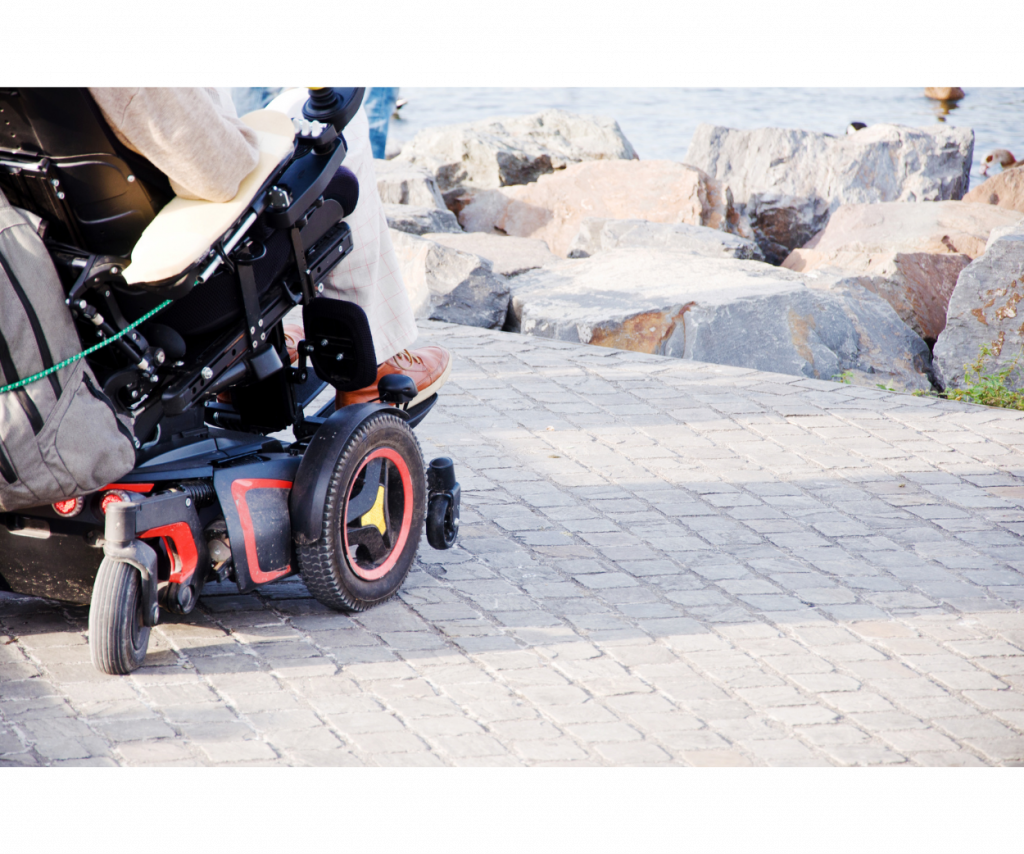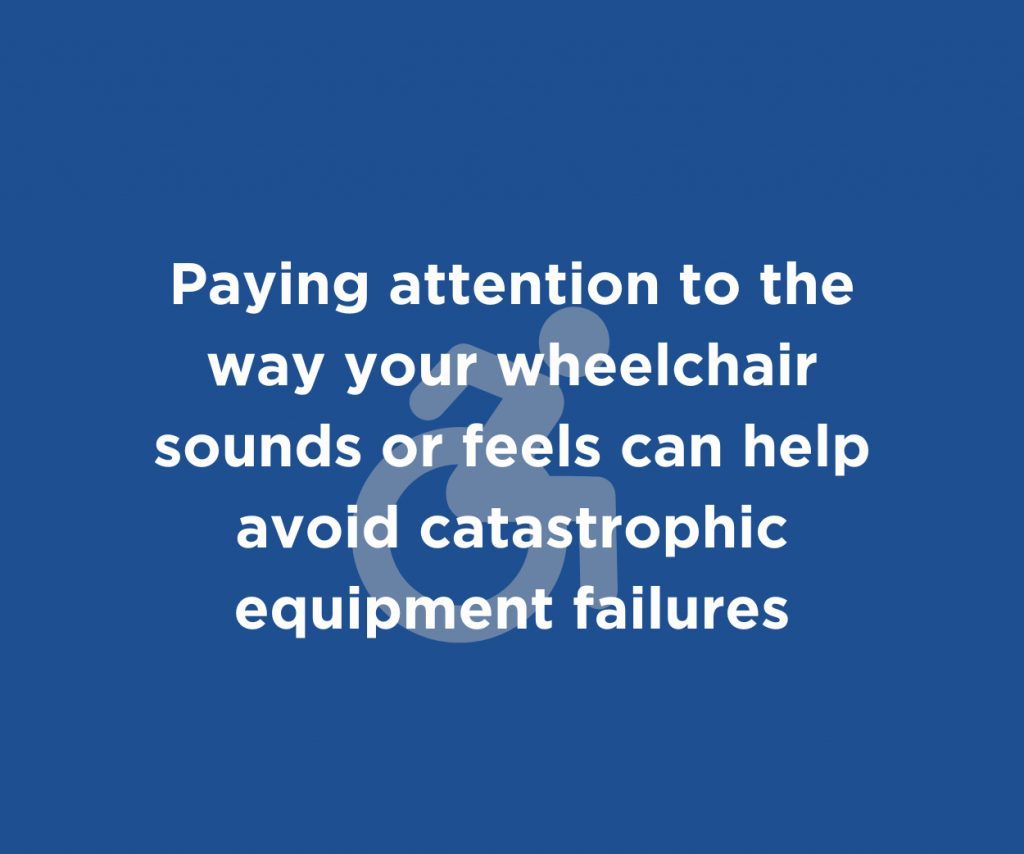Essential Preventive Maintenance for Wheelchair Riders
Steps you can take to keep your chair running smoothly PLUS how you can advocate for change
For wheelchair riders, well-maintained, functioning equipment isn’t just important, it’s vital.
Working manual or power chairs allow users to move through life—going to work or school, enjoying time with friends and family, running errands and living independently. A malfunctioning mobility device can disrupt these activities, leading to lost income, decreased independence and health complications.
To avoid these setbacks, it’s crucial to keep your equipment in optimal condition. Here are several small tasks you can perform regularly to extend your chair’s life.

- Clean your chair regularly.
Wipe down your chair with a damp cloth and mild detergent, focusing on areas that come in contact with your body, like armrests, seats, and headrests. This simple cleaning routine prevents grime from building up and keeps your chair looking and feeling fresh. Regular cleaning also helps prevent the spread of germs and illnesses, keeping you and your family healthier. - Care for the casters.
Front casters increase maneuverability but also tend to collect debris like hair and lint, which can impede performance. Clean casters regularly, and if necessary, remove the bolt to clear out trapped particles. You may need assistance from a caregiver or technician for this. Manual chair users should also check caster alignment and alert a technician to make these precision adjustments, so contact your local wheelchair provider such as National Seating & Mobility (NSM) to set up a maintenance check. Casters that are square and properly aligned will roll straighter, longer and easier.
- Wash cushions and other removable items.
Most wheelchair cushion covers are machine washable, so wash them regularly. Six months after delivery, you could qualify for a new cushion cover, so talk to your wheelchair professional about your options. Before washing, inspect the cover for excessive wear or tears and follow the care instructions provided in your user manual. Once the cover is removed, the actual cushion can be cleaned, but the method depends on what type of cushion you have. Also take a few seconds to clean underneath your cushion where dust and crumbs can easily collect.
REMINDER: Insurance may provide coverage for a new seat and back cushion every two years. Since the materials on seating may wear down, you should check with your wheelchair provider at the two year mark to consider replacement. You may only need a physician’s prescription for replacement, if it is not considered custom molded seating.

- Check all nuts and bolts on a regular basis.
Everyday use, rough terrain, and travel can loosen screws and bolts. Every few months, inspect your chair for loose hardware, especially on headrests, wheel locks and cushion hardware. Use an Allen key to tighten these areas. If you notice more complex issues, schedule a check-up with your local wheelchair provider. - Monitor tire pressure.
Low tire pressure makes manual chairs harder to push and makes it harder for power chairs to maneuver, so check the pressure regularly. Manufacturers often print the recommended pressure on the side of the tire. In addition to requiring users to push significantly harder, severely under-inflated tires can eventually cause damage to rims and spokes. Some wheelchair users may opt for flat-free inserts that use a lightweight polyurethane membrane and don’t require air. - Take care of the battery.
Power chair users should monitor their batteries for signs of wear, like dim lights, a rotten-egg smell or slow startup. To maintain battery health, fully charge it daily. Although most batteries reach full charge between 80-100%, leave the chair plugged in for two extra hours to ensure maximum capacity. Since chargers automatically shut off when fully charged, consider investing in an outlet timer to manage extended charging periods.
If your chair starts making unusual noises or feels off, reach out to your local wheelchair provider to schedule a check-up. If there is a broken component or something is malfunctioning, insurance may cover those repairs. Taking care of a problem early can often help avoid a catastrophic failure. If you don’t have a wheelchair provider, use the our branch locator to find an NSM branch near you.
ADVOCACY ALERT: Help Make Preventive Maintenance a Covered Benefit for Wheelchair Riders
While research has shown that preventive maintenance can play a vital role in preventing catastrophic failures, most insurance providers do not currently cover it. NSM and other industry advocates are supporting research and proposing legislation to make the case for preventative maintenance coverage.
In April 2024, Tennessee became the first state to pass a bill requiring Medicaid reimbursement for preventive maintenance, which the governor signed into law in late May. Ongoing advocacy efforts continue in other states, with advocacy organizations like the National Coalition for Assistive and Rehab Technology (NCART), the American Association for Homecare (AAHomecare) and the International Registry of Rehabilitation Technology Suppliers (iNRRTS) urging reform.
Ways you can get involved:
- Stay informed. Follow NCART, iNRRTS, AAHomecare and other advocates to stay up-to-date about ongoing efforts.
- Contact your local lawmakers. Find local elected officials and contact them to discuss the importance of preventive maintenance for CRT users.
Share your story. Personal experiences are powerful tools for change. Partner with advocacy organizations or use social media to share how coverage for preventive maintenance would help improve your life.
More Stories
Related Articles
What Are Your Transportation Options for Complex Rehabilitation Technology (CRT)-Related Appointments?
Pay It Forward: If you can travel to your wheelchair provider’s local branch for an appointment, do so. This can not only facilitate the repair...
5 Signs Your Complex Rehabilitation Technology (CRT) Equipment Might Need a Tune Up
Paying attention to the way your wheelchair sounds or feels can help avoid catastrophic equipment failures Your mobility equipment is the way you move through…


